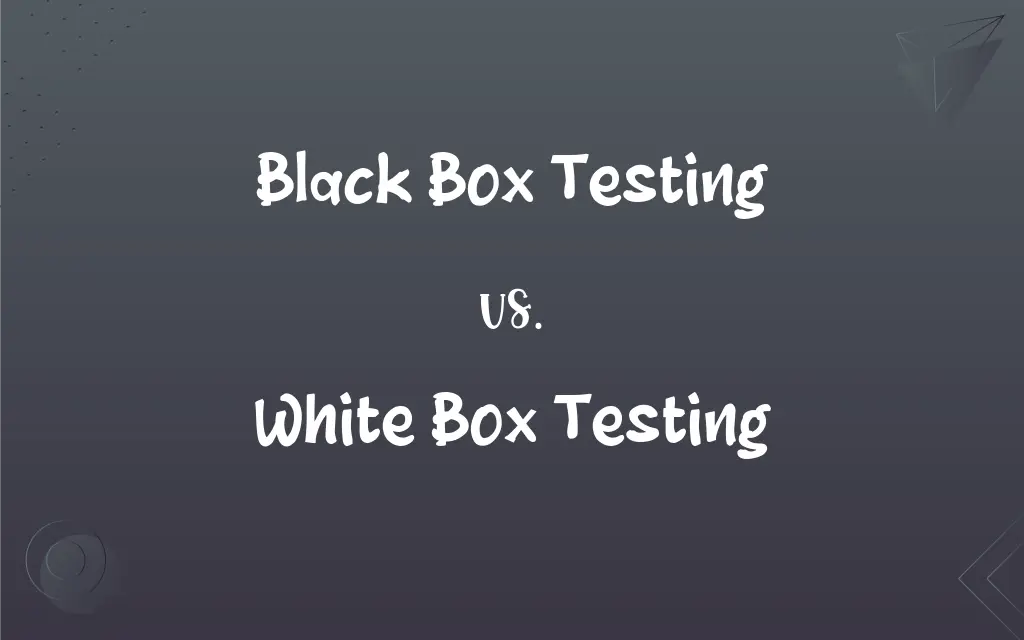Black Box Testing vs. White Box Testing: What's the Difference?
Edited by Aimie Carlson || By Janet White || Published on March 30, 2024
Black box testing assesses software without knowing its internals, focusing on outputs to inputs. White box testing involves understanding and testing the software's internal structures and workings.

Key Differences
Black box testing is a software testing technique where the tester evaluates the functionality of the software without any knowledge of the internal workings of the application. The tester inputs data and examines the output without considering how the application processes the data. White box testing, on the other hand, requires a deep understanding of the internal logic of the application. Testers use this knowledge to examine the code and ensure that all internal operations perform as expected.
In black box testing, the tester's lack of knowledge about the software's internals is intentional to ensure the testing process mimics the end-user experience. This approach helps identify discrepancies between the software's intended functionality and its actual behavior. White box testing differs in that it allows testers to scrutinize the internal mechanisms of the application, enabling them to identify potential hidden errors within the code that might not be apparent through external testing alone.
The methodologies used in black box testing often include functional testing, non-functional testing, and regression testing, among others. These methods focus on the software's output and behavior. White box testing techniques, such as unit testing, integration testing, and code coverage analysis, emphasize testing the software's internal structure, logic, and code.
Black box testing is advantageous when the test scenarios are not overly complex and when there is a need to evaluate the system's overall behavior without being bogged down by code-level details. White box testing is preferred when there's a requirement to perform an in-depth analysis of the application's internal workings, particularly for complex systems where understanding the codebase is crucial for assessing the software's integrity and security.
Black box testing is primarily concerned with the software's functionality and user interface, white box testing delves into the software's architecture and design. This fundamental difference highlights the complementary nature of both testing methods, with black box testing offering an outsider's perspective on the software's operation, and white box testing providing an insider's view of the software's construction and potential vulnerabilities.
ADVERTISEMENT
Comparison Chart
Knowledge of Code
No knowledge of the code is required.
Detailed internal knowledge of the code is necessary.
Testing Focus
Tests software functionality and user interface.
Tests internal structures, logic, and code paths.
Tester's Role
Tester acts as an end-user.
Tester requires programming and design knowledge.
Techniques Used
Functional, non-functional, and regression testing.
Unit, integration, and system testing; code coverage.
Objective
To validate behavior against specifications.
To verify internal operations and code quality.
ADVERTISEMENT
Black Box Testing and White Box Testing Definitions
Black Box Testing
Black box testing focuses on software output without knowing its internal mechanisms.
The team performed black box testing to ensure the login feature works as expected.
White Box Testing
It requires knowledge of the software's internal workings to design test cases.
Through white box testing, the team improved the encryption routines for enhanced security.
Black Box Testing
It evaluates the software by testing its functions against input and output criteria.
In black box testing, we discovered that the search functionality failed with special characters.
White Box Testing
White box testing involves examining and testing the software's internal code and structure.
White box testing was used to optimize the database query functions for better performance.
Black Box Testing
This testing method treats the software as an opaque entity, checking for expected results.
Black box testing helped identify a major flaw in the payment processing system.
White Box Testing
This method allows testers to identify hidden errors within the software's code.
White box testing uncovered a memory leak in the application's file handling module.
Black Box Testing
Black box testing is independent of the software's code structure.
Without looking at the code, black box testing was used to validate the checkout process.
White Box Testing
White box testing aims at covering code paths, branches, and conditions.
The developer used white box testing to ensure all conditional branches were executed.
Black Box Testing
Black box testing is used to assess the software's external behavior.
Black box testing revealed inconsistencies in the application's error handling.
White Box Testing
White box testing is conducted with an understanding of the software's architecture.
By applying white box testing, the team verified the integration between various modules.
FAQs
What is white box testing?
White box testing is a technique where testers need a detailed understanding of the internal workings of the software to test it.
How does black box testing work?
In black box testing, testers input data and examine outputs to assess if the software behaves as expected, without considering how the software processes the data.
What does white box testing involve?
White box testing involves looking into the software's code, structure, and internal logic to create tests that cover all possible paths and conditions.
Who performs black box testing?
Typically, QA engineers or testers who focus on the functional aspects of the software perform black box testing.
What is black box testing?
Black box testing is a method where testers evaluate software functionality without any knowledge of the internal code or structures.
What are the benefits of black box testing?
Black box testing helps ensure the software meets user requirements and behaves as intended from an end-user's perspective.
Who is responsible for white box testing?
Software developers or testers with programming knowledge usually conduct white box testing to ensure code quality and logic correctness.
Can black box testing be automated?
Yes, black box testing can be automated, especially for regression tests and other repetitive tasks.
Is white box testing always manual?
White box testing can be both manual and automated, especially when it comes to unit testing and code analysis tools.
Give an example of white box testing.
Analyzing the source code of a web application to ensure that all security protocols are correctly implemented in the login feature.
What is an example of black box testing?
Testing a web application's login feature by inputting various usernames and passwords without knowing how the authentication process works internally.
When is black box testing most effective?
Black box testing is most effective in the early stages of development and for validating functional requirements.
When should white box testing be applied?
White box testing is best applied during the development phase, where it can influence design decisions and code quality.
What tools are used for black box testing?
Tools like Selenium, QTP, and LoadRunner are commonly used for automation in black box testing.
What advantages does white box testing offer?
White box testing provides an in-depth analysis of the code, identifying potential security issues, logic errors, and improving code quality.
Can black box testing identify internal errors of the software?
Black box testing may indirectly identify internal errors if they affect the software's external behavior, but it cannot pinpoint the errors within the code.
How does white box testing contribute to software security?
By examining the internal code, white box testing can identify security vulnerabilities and enforce coding standards to mitigate risks.
What tools are involved in white box testing?
White box testing often uses unit testing frameworks like JUnit, NUnit, and code analysis tools like SonarQube.
How does black box testing handle user experience issues?
Black box testing can identify user experience issues by testing the software from an end-user's perspective, focusing on usability and accessibility.
In what way does white box testing improve code efficiency?
White box testing can improve code efficiency by identifying and eliminating unnecessary code paths and optimizing algorithms.
About Author
Written by
Janet WhiteJanet White has been an esteemed writer and blogger for Difference Wiki. Holding a Master's degree in Science and Medical Journalism from the prestigious Boston University, she has consistently demonstrated her expertise and passion for her field. When she's not immersed in her work, Janet relishes her time exercising, delving into a good book, and cherishing moments with friends and family.
Edited by
Aimie CarlsonAimie Carlson, holding a master's degree in English literature, is a fervent English language enthusiast. She lends her writing talents to Difference Wiki, a prominent website that specializes in comparisons, offering readers insightful analyses that both captivate and inform.
































































